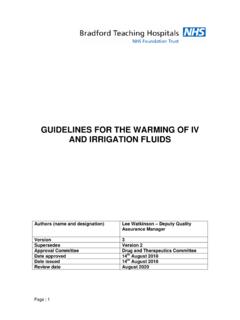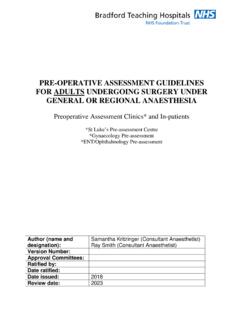Transcription of Neonatal Ventilation – basics of mechanical ventilation
1 Neonatal Ventilation basics of mechanical Ventilation Authors: Sam Wallis - Catriona Firth Approved by: Neonatal Guidelines Group 04/03/2014. No change 2017 Reviewed Sept 2019. Review date: 17/09/2022 Version: 2 mechanical Ventilation in Neonates Introduction Additional respiratory support is required when babies are unable to achieve satisfactory gas exchange by themselves. Whilst we now commonly use non-invasive techniques (CPAP / Hi-flow), a good understanding of how and when to use mechanical Ventilation is a key part of Neonatal practice. Although most of our babies require ventilating because of lung problems related to prematurity, we also see a number of pathologies that require very different strategies. For example, meconium aspiration, PPHN, or infants with normal lungs who require Ventilation for other reasons (such as hypoxic brain injury or a neuromuscular disorder).The following is therefore intended as an introduction to the basics and an initial guide.
2 It is not a protocol. There are no magic ventilator settings that work in all situations and you will find practice varies between individuals. Related guidelines BEaCoN early care of the newborn Surfactant Therapy PPHN Saturation monitoring on the Neonatal unit Endotracheal Intubation NICE guidance Specialist Respiratory care for babies born preterm Contents 1. Basic principles of Ventilation 2. The Drager ventilator 3. Modes of Ventilation 4. Suggested Settings 5. Blood gas interpretation 6. Changing Ventilation settings 7. Weaning and extubation 8. Trouble shooting a. Deterioration on the ventilator b. Optimising mechanics c. Alarms 9. HFOV a. Oxygenation index calculator 1. Basic Principles Indication for intubation / Ventilation For early care of preterm infants see BEaCoN guidance This decision should be discussed with your senior but we may intubate and ventilate in the following circumstances Oxygenation / Ventilation The goal of Ventilation is to achieve satisfactory Oxygenation and Ventilation .
3 Oxygenation (PaO2) is determined by the Inspired oxygen fraction (FiO2) and Mean airway pressure (MAP). Ventilation (CO2 clearance) is determined by the Minute Volume (MV= Tidal Volume (VT) x Rate (R)). The mechanical ventilators used on NNU allow us to control both oxygenation and Ventilation by adjusting the parameters outlined below. Look at the simplified Pressure / Time curve, a version of this can be seen on the ventilator screens on the unit This illustrates what respiratory support is being delivered to the baby PIP or Pinsp = Peak inspiratory pressure (pressure delivered during inspiration) PEEP = Positive end expiratory pressure ( baseline pressure maintained during expiration) Ti = Inspiratory time Te = Expiratory time Ti + Te = 1 respiratory cycle (number of cycle / minute = Rate). Reducing Te increases rate. VT = Tidal volume the volume of gas moved with each breath (the difference in PIP and PEEP will determine the VT delivered) 1.
4 Apnoea/bradycardia (recurrent) 2. Respiratory failure (clinical) 3. Deteriorating blood gases PEEP P Time PIP / Pinsp Ti Inflation pressure will determine VT Te Oxygenation Positive pressure opens up the lung and (with an oxygen containing gas) allows oxygenation of the alveoli. The Mean Airway Pressure is the combination of PIP and PEEP represented by the shaded area under the pressure / time curve. Increasing either PIP or PEEP will increase this area and therefore oxygenation. The way this is done depends on the mode selected (see Modes below). Increasing Ti also increases this area under the curve and can be used to improve oxygenation in some circumstances. Ventilation Movement of gas in and out of the lung allows CO2 to be excreted. CO2 clearance increases (and therefore PaCO2 falls) with an increase in Minute Volume (the volume of gas moved in and out of the lungs every minute). As Minute Volume is a product of Respiratory rate and Tidal Volume (gas moved with each breath), increasing either of these should increase CO2 clearance.
5 Increasing Rate is easy on modern ventilators. As the Ti is set separately, the machine alters rate by automatically changing the expiratory time (Te) according to the number of breaths / minute you select. Increasing Tidal Volume is achieved by increasing PIP (or much less commonly by decreasing PEEP). The machine will do this for you in Volume Guarantee mode (see below) but needs to be done manually in Pressure limited modes. Deciding which parameter to change takes practice. As you can appreciate, certain alterations will affect both Oxygenation and CO2 clearance increasing PIP for example (either directly or by altering VT settings) will increase Oxygenation and CO2 clearance. To use the ventilator safely, you will need to be able to anticipate the effect of these changes. Increase oxygenation Increase FiO2 Increase MAP (PIP +/-PEEP) Increase Ventilation (= decreasePaCO2) Increase VT Increase Rate 2. Drager Ventilators VN 500 We use the Drager Babylog VN500 ventilator with Infinity C500 touchscreen display.
6 The ventilator receives piped oxygen and air from the wall. A Fisher-Paykel breathing circuit is attached to the front. The inspiratory blue hose is passed through a humidifier to make sure warmed, moist gas is delivered to the baby. The white hose is the expiratory limb which passes gas back to the machine. The circuit needs to have low compliance so as much of the delivered volume gets to the baby as possible A flow sensor is attached between the circuit and the end of the ET tube. This is a crucial piece of kit which feeds back flow and volume information to the ventilator. It is calibrated before use and needs to be kept free of moisture The ventilator is fairly easy and intuitive to use. A vast amount of information is available within the ventilator itself take some time to look at the displays and familiarise yourself with how to change functions. 3. Modes of Ventilation As with all modern ventilators there are lots of ways it can be set up to deliver respiratory support.
7 This can be confusing but the basic principles remain the same and in practice we actually only use 2 or 3 different modes. Terminology Synchronisation Most of our babies are not paralysed with muscle relaxants. As such they can make their own breathing effort whilst being mechanically ventilated. All our commonly used modes are therefore synchronised the ventilator tries to co-ordinate mechanically delivered breaths with the baby s own spontaneous respiratory effort. The ventilator does this by allowing a baby the chance to initiate a breath within a certain time window. Baby s spontaneous breathing efforts are detected by small changes in flow across the flow sensor. The sensitivity of the flow sensor can be adjusted (flow trigger) if necessary. Sometimes fluid in the breathing circuit can mimic the flow changes of a spontaneously breathing baby this is called auto-trigger (see below) Pressure vs Volume guided (VG) Ventilators keep lungs inflated by applying positive pressure.
8 The continuous background pressure is known as PEEP and is important to stop lungs collapsing. Intermittently the ventilator will increase the pressure (PIP or Pinsp) to drive air into the lungs and deliver a breath. The pressure the ventilator delivers is selected by you. Historically this was done by simply dialling in a Pinsp (cm H20). This is fine but the amount of gas (tidal volume VT) actually delivered is not just dependent on pressure it is also determined by the compliance of the lung you are ventilating. A stiff lung will inflate less than a compliant lung for the same applied pressure. This is important for a number of reasons - Gas exchange is determined by the tidal volume. - Lung compliance can change over time (rapidly in the case of preterm infants receiving surfactant) therefore a selected PIP will deliver different tidal volumes at different times. - Lungs are damaged by mechanical Ventilation . Over distension from excessive tidal volumes (volutrauma) is one of the chief mechanisms by which this occurs.
9 Modern ventilators now allow you to select the tidal volume you want to deliver by adding Volume Guarantee to your set mode. Usually this is set between 4-5ml/kg. The ventilator will then automatically alter the PIP (below a maximum limit) to deliver a consistent tidal volume regardless of changes in compliance. Theoretically this reduces the risk of overdistension, particularly in newborn preterm infants. Use of VG / Volume Guarantee is increasingly popular and, for many neonatologists, the default option. However it is not always the right choice it relies on accurate measurement by the flow sensor and does not work well where there is a large leak (>50%) around the ET tube. Pressure limited Set Peak pressure Variable Tidal Volume Volume Guarantee Set Tidal Volume Variable Peak Pressure Modes (con) Don t worry too much about the following acronyms they are designed to confuse and vary with manufacturer. PC-AC (SIPPV in old money) or SIMV are our standard modes.
10 PC-AC means all breaths (ventilator and baby initiated) are supported by the ventilator. The baby therefore does not have to do the extra work of drawing in air through a ventilator circuit and ET tube. Of note - for babies breathing above the back-up rate, weaning Ventilation by reducing the rate will have no effect. SIMV means only the set rate back-up breaths are supported. This allows greater control in terms of weaning but means spontaneously breathing babies have to expend greater energy breathing at faster rates. Both modes are synchronised and both can have Volume Guarantee. Just to confuse you there is also an option to add additional P support in SIMV mode. This can be viewed as a half way house between SIMV and PC-AC. Ventilator breaths are supported at the selected PIP, however additional, patient initiated breaths above the back-up rate are given some extra support (at whatever delta-P you select above PEEP). The idea is that the ventilator can help the baby overcome the resistance of spontaneously breathing through an ET tube / circuit without needing to give a full ventilator breath each time.



